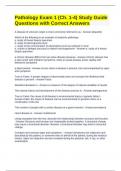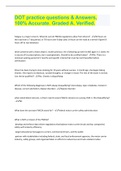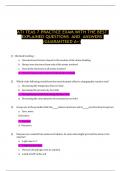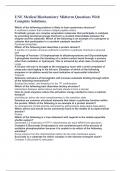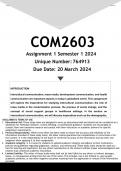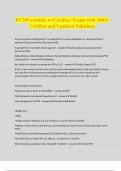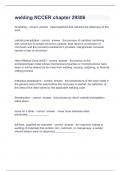Questions with Correct Answers
A disease of unknown origin is more commonly referred to as - Answer-idiopathic
Which of the following is an example of anatomic pathology
a. study of breast biopsy specimen
b. study of blood glucose level
c. study of the concentration of electrolytes (such as sodium) in urine
d. culture of phlegm (mucous) to detect microorganisms - Answer-a. study of a breast
biopsy specimen
a chronic disease differs from an actue disease because - Answer-chronic disease has
a slow onset with indistinct symptoms, while an acute disease arises rapidly with
distinctive symptoms
a latent period - Answer-occurs when a disease is present, but unaccompanied by signs
and symptoms
True or False: A greater degree of abnormality does not increase the likelihood that
disease is present - Answer-False
Standard deviation is - Answer-a measure of the degree of natural variability of results
The natural history and development of the disease process is - Answer-pathogenesis
True or False: the cause of all disease is environmental injury or genetic defect -
Answer-False: the cause of disease can be environmental or genetics alone or a
combination of the two
The number of people with a certain disease at a given moment - Answer-prevalence
Heart disease is - Answer-mulifactoral
Using examples from the text, describe the relationship between structure and function.
- Answer-Structure and function are inseparably locked together. A structural change
may cause a functional disorder; likewise, a functional disorder may lead to structural
change
Compare and contrast signs and symptoms. - Answer-Symptoms are subjective and
described by the patient, or someone else on behalf of the patient, during the medical
history. Signs are objective and are revealed during the physical, lab, X-ray, or other
examination.
,Sensitivity is to false positive as - Answer-specificity is to false negative
What roles do our environment and our genetics play in causing disease? Consider
examples along the continuum. - Answer-The causes of disease are on a continuum
between environmental injury and genetics. An example of a disease due to
environment would be burns; one due to genetics would be cystic fibrosis. Examples of
both are much more common and include lung cancer, heart disease, and high blood
pressure.
Compare and contrast clinical and anatomic pathology - Answer-Clinical pathology is
the study of the functional aspect of disease and includes measurements taken on
tissue, blood, or urine (e.g., blood glucose). Anatomic pathology is the study of
structural changes, which can be assessed postmortem (autopsy) or on living tissue
taken from a patient (biopsy).
In screening a population for a lethal disease, what factors affect the type of test that
you will choose? Consider sensitivity, specificity, prevalence, and predictive value. -
Answer-In the case of a lethal disease, missing the disease in a person might cause
grave consequences; therefore, a test with high sensitivity is warranted. Such a test
would guarantee that no person with the disease would be missed. The sensitive test
can then be followed up with a specific test to distinguish patients with a false positive
result from a true positive result. Indeed, any false diagnosis of a lethal disease needs
to be avoided.
In populations where the prevalence of a disease is high, a positive result is more likely
to be truly positive, regardless of how good the test is. Therefore, by using a sensitive
test only in the part of the population where we suspect the disease, we can increase
the positive predictive value of the test. Of course, the sensitive test should be followed
by a specific test to confirm the finding.
Discuss health and sickness versus normal and abnormal in the context of true positive,
false positive, true negative, and false negative - Answer-Health is the absence of
disease, while sickness is its presence. Tests performed to detect the disease are said
to be positive if the result is abnormal (suggesting presence of disease) and negative if
the result is normal (suggesting the absence of disease). In patients where the test is
positive and the disease is present, the result is said to be a "true positive." In cases
where the test is positive and the disease is absent, the result is said to be a "false
positive." Conversely, in the absence of disease (the patient is healthy), a negative
result is a "true negative." Finally, in a patient with the disease, a negative test result is
said to be a "false negative."
True or false: a functional disorder can lead to a structural change - Answer-true
True or False: acute disease typically begins with manifestations that are difficult to
interpret - Answer-false: chronic disease typically begins with manifestations that are
difficult to interpret
, what is the scientific name for a period of vague, early manifestations that herald the
coming of more pronounced disease? - Answer-Prodromal period
What is the name for a short period of increased intensity of disease? - Answer-
exacerbation
what is the scientific name for the cause of a disease - Answer-etiology
what is the scientific name for a structural abnormality of disease - Answer-lesion
True or False: the incidence of a disease is the number of new cases of a particular
disease that appear in a year - Answer-True
True or False: a patients ability to read ad comprehend prescription- drug information is
a determinant of health - Answer-true
Is an abnormality observed by a nurse a sign or symptom? - Answer-sign
True or false: a biopsy is an examination of a tissue specimen to determine the cause of
death - Answer-False: a biopsy is an examination of a living tissue
What is the name for a distinctive collection of symptoms, signs and data? - Answer-
syndrome
True or False: all sick patients will have at least one abnormal test - Answer-false
What percentage of the test results in healthy people fall within the mean plus and
minus two standard deviations - Answer-95%
The ability of a test to be positive int he presence of disease is - Answer-sensitivity
True or false: the best testing strategy is to start with highly sensitive tests and follow
with highly specific ones - Answer-True
True or False: a multipotent stem cell has the ability to produce any kind of tissue -
Answer-False
Which tissue is made of labile cells - Answer-bone marrow
in what ways can cells be injured - Answer-inadequate oxygen, physical or chemical
agents, ionizing radiation, toxins, microbes, inflammation and immune reactions,
nutritional imbalance, genetic and metabolic defects, and aging
Which of the following is derived from the endoderm? - Answer-pancreas

